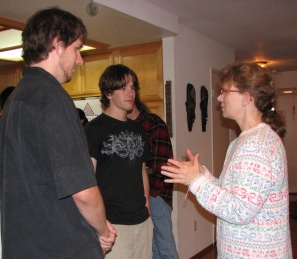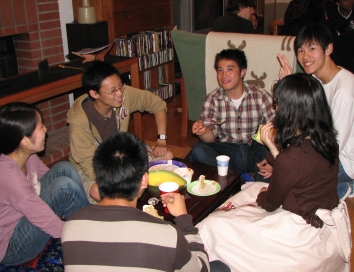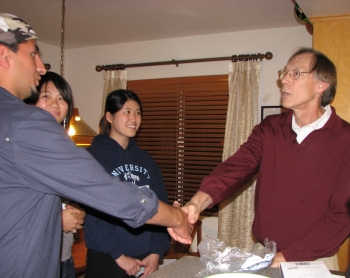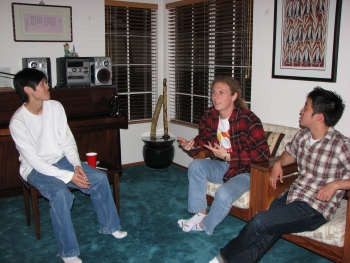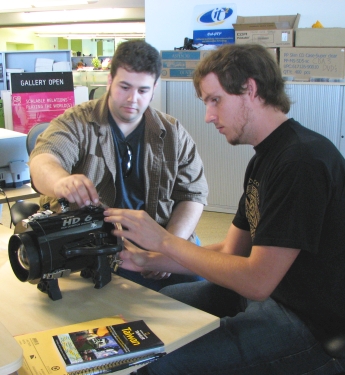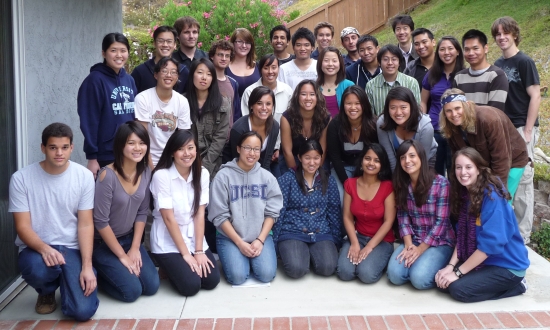Host Institution
Mentor/s: Host
UCSD Mentor |
PRIME student, major and project summary |
Monash University, Melbourne, Australia
Mentors: David Abramson
UCSD: Kim Baldridge |
Elisa Abate, bioengineering: premedical
This project involves enhancement and use of a framework being designed for ligand-protein investigations. Using computational chemistry software of Prof. Baldridge and the workflow tools of Prof. Abramson, the goal will be to do several parametric experiments to investigate changes in structure, environment, and methodology, and record the results for further analysis. |
University of Hyderabad, India
Mentors: Arun Agarwal and Anand K. Kondapi
UCSD: Jason Haga |
Dee Chen, bioengineering
My goal is to screen other members of the DSP family that ensure the inhibitors found from the SSH-2 screen are specific for SSH-2, using DOCK6 installed on the PRAMA grid sites. |
National Museum of Marine Biology and Aquarium (NMMBA), Kenting, Taiwan and National Center for High-performance Computing (NCHC) Taichung, Taiwan
Mentors: Tony Fan and Fang-Pang Lin
UCSD: Ryan Kastner |
Robert Chen, computer engineering
My project will involve the application of various image processing techniques for the purpose of characterizing coral larvae blooms. Image and video processing will utilize parallel computing while the processed data will be streamed into the DataTurbine middleware. |
University of Waikato, Hamilton, New Zealand
Mentors: David Hamilton
UCSD: Jane Teranes |
Jacqueline Chin, environmental engineering
Analysis and modeling of the effects of non-photochemical quenching on chlorophyll fluorescence to better analyze algal biomass growth in the lakes of Lake Rotorua because of the abundance of accurate chlorophyll fluorescence data (except for cases of quenching). |
Monash University, Melbourne, Australia
Mentors: David Abramson
UCSD: Anushka Michailova |
Ramya Chitters, bioengineering-biotechnology
The goal of my project is to use NIMROD/E to perform parameter sensitive analysis in cardiac electrophysiological models. |
National Taiwan University (NTU), Taipei, Taiwan
Mentors: Jung-Hsin Lin
UCSD: Wilfred Li |
Jennifer Choy, biochemistry and cell biology
The goal of this research project is to utilize virtual screening, docking, and off-target analysis to design inhibitors that will preclude the Non-Structural Protein 1 (NS1) from binding to the double-stranded RNA (dsRNA) to utilize the host cell’s mechanisms to replicate and distribute its own genetic material; ultimately terminating the host immune system. A second goal of this project is to develop small molecule drugs to ameliorate the human influenza A H5N1 virus infection. |
Cybermedia Center, Osaka University, Osaka, Japan
Mentors: Susumu Date
UCSD: Jason Haga |
Allyson Clark, bioengineering
This research project involves verifying SSH-2 inhibitor specificity through virtual screening experiments on the grid. |
Monash University, Melbourne, Australia
Mentors: David Abramson
UCSD: Jürgen Schulze |
Nicholas Echols, computer science, interdisciplinary computing and the arts (ICAM)
The goal of my project will be to create a viewing interface on the tiled-display wall for both 2-D images and 3-D image stacks acquired from the confocal microscope at Monash University. This interface will visually act as a two dimensional plane along which the images can be moved, rotated, and scaled. The interface will also provide interaction with multiple users, each being able to independently manipulate the images on the plane. The users will ideally use wiiremotes to carry out interaction, but the software should facilitate use with any pointing device. |
National Institute for Information and Communications Technology (NiCT), Tokyo, Japan
Mentors: Kaori Fukunaga and Shinji Shimojo
UCSD: Maurizio Seracini |
Isabelle Fanchiu, interdisciplinary computing and the arts (ICAM)
Under Professor Maurizio Seracini's supervision, I will be building panels painted with different colors and types of paint as a standard measurement. I will bring the panels to Tokyo to begin the analysis of colors and materials with the THz scanning technology, compile the data, and document digitally at Dr. Kaori Fukunaga's lab at NiCT in Japan. |
Doshisha University, Kyoto, Japan
Mentors: Nozomu Inoue
UCSD: Robert Sah |
Utsav Gupta, bioengineering: biotechnology
The goal of this project is to develop digital image processing methods to determine synovial fluid volume of the knee using 3-D imaging data. This has implications for diagnosis of osteoarthritis and monitoring after therapeutic intervention. |
University of Auckland, New Zealand
Mentors: Jason Ingham and Liam Wotherspoon
UCSD: Lelli Van Den Einde |
Jefferson Hang, structural engineering
I will be helping the University of Auckland set up a network infrastructure that will allow them to collect data during experiments, upload it to their server, provide real-time stream to other researchers. All of this will be done through their network, LabView, NEESdaq, Data Turbine, and RDV. |
Universiti Sains Malaysia (USM), Penang, Malaysia
Mentors: Habibah Wahab
UCSD: Wilfred Li |
Jessica Hsieh, bioengineering: biotechnology
My proposed PRIME project is to optimize the design of small interfering RNAs (siRNAs) test probes targeting the nucleocapsid protein (NP) in the influenza virus. |
National Center for Research on Earthquake Engineering (NCREE), Taipei, Taiwan
Mentors: Keh-Chyuan Tsai
UCSD: Lelli Van Den Einde |
Lori Jue, structural engineering
I will be helping with research and testing of Specially Concentric Braced Frames at the National Center for Research on Earthquake Engineering. |
Cybermedia Center, Osaka University, Osaka, Japan
Mentors: Susumu Date
UCSD: Jürgen Schulze |
Sasha Koruga, mathematics-computer science
To use Osaka University’s laser and camera system to capture a human subject in motion, and then to render such subject realistically in Calit2's pentagon-shaped virtual reality room (dubbed the StarCave) in real time with high-quality textures and detail. |
National Institute for Information and Communications Technology (NiCT), Tokyo, Japan
Mentors: Shinji Shimojo and Taku Morinobu
UCSD: Jürgen Schulze |
Jade Kwan, cognitive science: human computer interaction
I will be working on data visualization taking scientific datasets to create an artistic 3-dimensional mapping. I will use software called Autodesk Maya to model and script these mappings to then present them on high resolution tiled-display walls. |
Cybermedia Center, Osaka University, Osaka, Japan
Mentors: Susumu Date
UCSD: Jason Haga |
Christopher Lau, bioengineering
My project is to incorporate various computer programs to visualize the results of virtual protein screening on a tiled-display wall. Because individuals need to compare hundreds of receptor-ligand interactions, multiple side by side comparisons using a tiled-display wall would lead to more effective and less time consuming analysis. |
National Museum of Marine Biology and Aquarium (NMMBA), Kenting, Taiwan and National Center for High-performance Computing (NCHC) Taichung, Taiwan
Mentors: Tony Fan and Fang-Pang Lin
UCSD: Doug Palmer |
Tsung Han Lin, computer science
Monitoring plankton is important in understanding current marine ecosystems. I will be developing a Plankton Automatic Recognition System to improve the efficiency of the plankton monitoring. |
Universiti Sains Malaysia (USM), Penang, Malaysia
Mentors: Habibah Wahab
UCSD: Wilfred Li |
Jessica Liu, biochemistry and cell biology
I will conduct research on neuraminidase through the usage of hierarchical screening to identify similar compounds which may also be active against neuraminidase. In addition, I will conduct off-target analysis to identify previously unknown targets in the human proteome which may be negatively affected by these neuraminidase hits. |
University of Hyderabad, India
Mentors: Arun Agarwal, K.V. Subbarao and Rajeev Wankar
UCSD: Tony Fountain and Sameer Tilak |
Brian McMahon, computer science
I will be setting up a data streaming system for a sensor network in the Bay of Bengal. This system will be used to allow near real-time access to data for researchers to study, and possibly predict tsunami activity. To accomplish this task, I will be working with Dr. Tony Fountain of Calit2 and utilizing DataTurbine software. |
University of Hyderabad, India
Mentors: Arun Agarwal and Anand K. Kondapi
UCSD: Jason Haga |
Matthew Mui, bioengineering: premed
The goal of the project is to find a specific inhibitor for a dual specificity phosphatase called SSH-2 using the Pragma Grid. |
National Museum of Marine Biology and Aquarium (NMMBA), Kenting, Taiwan and National Center for High-performance Computing (NCHC) Taichung, Taiwan
Mentors: Tony Fan and Fang-Pang Lin
UCSD: Tony Fountain |
Michael Nekrasov, computer engineering
The goal of this project is to engineer a real-time system for studying coral, particularly focusing on coral larvae and the fluorescence of coral. Cameras capable of registering fluorescence will be integrated into DataTurbine, a computer system for environmental observing. The images captured will allow scientists to study coral health as well as capture interesting phenomena like coral blooms. |
Cybermedia Center, Osaka University, Osaka, Japan
Mentors: Susumu Date
UCSD: Masahiko Hoshijima |
Anna Pham, general biology
Using computational tools, I will work to tailor the 3-D visualization of cardiac dynamic physiological events to make it more comprehensive. |
National Center for Research on Earthquake Engineering (NCREE), Taipei, Taiwan
Mentors: Keh-Chyuan Tsai
UCSD: Lelli Van Den Einde |
Sabina Piras, structural engineering
I will be conducting research and applying instrumentation on Specially Concentric Braced Frames at the National Center for Research on Earthquake Engineering. |
Monash University, Melbourne, Australia
Mentors: David Abramson
UCSD: Roy Kerckhoffs |
Scott Revelli, bioengineering
This summer I plan on analyzing a fully coupled electromechanic model of a healthy canine heart by using Nimrod to run parameter variations on the model. Through parameter variations I aim to be able to identify the distribution of myocardial cells, by comparing known characteristics of the different cells and the heart’s reactions to different strains. |
University of Auckland, New Zealand
Mentors: Poul Nielsen
UCSD: Roy Kerckhoffs |
Amir Shirkhani, computer engineering
Continuity is a multi-scale modeling software written in Python. The project is to develop a module for the current version of Continuity that would allow users to import CellML models. The module needs to be developed in Python as well. |
Monash University, Melbourne, Australia
Mentors: David Abramson
UCSD: Jürgen Schulze |
Adi Singer, computer science
My project will utilize the tiled-display walls at Monash University to create a 3-D geographic model allowing users to fly around and interact with existing city buildings and terrain. Useful for scientific research such as flood patterns, as well as fun to use. The OpenSceneGraph software I am developing to implement these virtual models will port the modeling algorithm currently being researched by Peter Serwylo, an IT student from Monash. |
Computer Network Information Center, Chinese Academy of Sciences (CNIC CAS), Beijing, China
Mentors: Kai Nan
UCSD: Wilfred Li |
Michael Siy, biology: physiology and neuroscience
This summer I aim to evaluate the feasibility of the relaxed complex scheme for high affinity small molecule inhibitors for the hemagglutinin (HA) receptor-binding domain of the influenza virus. I would also like to develop a trimeric interface inhibitor against HA, through virtual screening using the relaxed-complex method, to stop conformational change of the trimers needed for membrane fusion. |
Doshisha University, Kyoto, Japan
Mentors: Nozomu Inoue
UCSD: Koichi Masuda |
Andrew Sou, microbiology
The degeneration of facet joint cartilage is caused by opposing articular surface contact during flexion and extension; this can be systematically represented by the construction of a three-dimensional (3-D) computerized tomography (CT) model. The specific aims are to determine physiologic bending kinematics based on literature: intersegmental angles during flexion, stand, extension and to obtain CT data suitable for analysis and reconstruction of a 3-D computer model via the volume-merge method. |
Cybermedia Center, Osaka University, Osaka, Japan
Mentors: Susumu Date
UCSD: Raj Singh |
Cory Stevenson, bioengineering: biotechnology
Developing software to effectively view very large images through SAGE on the tiled-display wall. |
National Museum of Marine Biology and Aquarium (NMMBA), Kenting, Taiwan and National Center for High-performance Computing (NCHC) Taichung, Taiwan
Mentors: Tony Fan and Fang-Pang Lin
UCSD: Jennifer Smith |
Winny Wen, environmental systems (ecology, behavior, & evolution)
Using several different video recording devices, I hope to be able to capture different competition techniques between different corals themselves and those with other species native to their habitat. |
Computer Network Information Center, Chinese Academy of Sciences (CNIC CAS), Beijing, China
Mentors: Kai Nan
UCSD: Wilfred Li |
Chelsea Wong, human biology
The first aim of my project is to characterize possible drug resistance by neuraminidase mutants and gain a better understanding of the mechanisms involved in the resistance emergence to a wide use of inhibitors of influenza virus neuraminidase. The second aim of my project is to do off-target analysis on drug candidates to see if they cause any toxicities or side effects, in particular, with focus on compounds that may inhibit all known viral neuraminidase and neuraminidase mutants. |
Doshisha University, Kyoto, Japan
Mentors: Nozomu Inoue
UCSD: Koichi Masuda |
Ling (Kelli) Xu, bioengineering: premedical
Use nano CT to examine the 3-D microstructure of the endplate responsible for nutrient transport to the intervertebral disc and correlate its structural variations with differences in its fluid permeability to better understand how the change in the structure of the endplate contributes to the progression of osteoarthritis. |
Cybermedia Center, Osaka University, Osaka, Japan
Mentors: Susumu Date
UCSD: Jason Haga |
Wen-wai Yim, bioengineering
To create a virtual layer on parallel processing computer clusters such that the molecular docking process (using the UCSF docking program Dock6) can be reliably and precisely performed on any computer cluster, regardless of local settings. |

